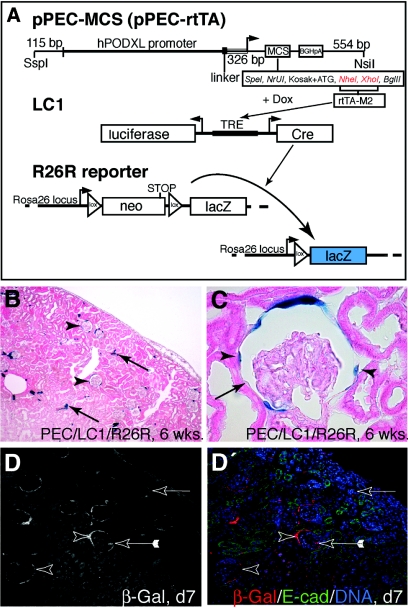Figure 6.
Genetic tagging of PECs in a triple-transgenic doxycycline-inducible rtTA mouse line. (A) pPEC-MCS, the rabbit podocalyxin cDNA, was replaced by a multiple cloning site (MCS; available restriction sites indicated). The enhanced tetracycline reverse transactivator (rtTA-M2) was cloned into Nhe1/Xho1 (red). pPEC-rtTA–transgenic mice were generated by pronuclear injection and mated to LC1 mice expressing Cre recombinase and luciferase under the control of tetracycline-responsive elements (TRE), which can be activated by rtTA-M2 in the presence of doxycycline and R26R: This reporter line irreversibly expresses β-gal (LacZ) under the control of the ubiquitous ROSA26 locus only after Cre excision of an interposed floxed neomycin cassette (neo; acting as a stop signal) has occurred. (B) Genetic labeling of PECs using doxycycline in 6-wk-old triple-transgenic pPEC-rtTA mice (pPEC-rtTA/LC1/R26R; 9 wk of age). Sporadic labeling was observed in some tubular cells of the renal cortex (arrows). (C) After induction, Cre recombination occurred in 72% of all PECs (arrowheads, labeled PEC; arrow, unlabeled PEC). (D and D′) Cre recombination was induced in triple-transgenic mice 5 d after birth (d5), when nephrogenesis still persists. Two days after doxycycline administration (d7), specific genetic labeling of PECs was verified by immunofluorescent staining (arrowheads). In 1 to 2% of all glomeruli, labeled cells on the glomerular tuft were observed (arrow with tails, confocal triple-immunofluorescent labeling; red, β-gal [genetic marker for PECs]; green, E-cadherin (proximal tubular cell marker); blue, DNA).

